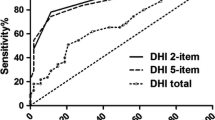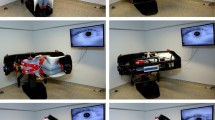Abstract
Objective
The purpose of this study was to assess residual dizziness (RD) after successful canalith repositioning maneuvre (CRM) treatment in patients with benign paroxysmal positional vertigo (BPPV) using Dizziness Handicap Inventory (DHI) questionnaire and Visual Analog Scale (VAS).
Methods
One hundred sixty BPPV patients after successful CRM treatment were recruited. All patients were divided into the residual dizziness (RD) group and without RD group. The DHI questionnaire and VAS before CRM and follow-up were asked to complete. For analysis of the improvement in symptom, we defined ∆DHI and ∆VAS as the difference between the baseline score and the follow‐up score.
Results
High incidence of RD was observed in the older patients (p < 0.001). The incidence of hypertension in the RD group was also significantly higher than that of the without RD group (p = 0.022). The ∆DHI-P, ∆DHI-E, ∆DHI-F, ∆DHI-T, and ∆VAS scores in the without RD group were significantly higher than that of the RD group (p < 0.001). When the cutoff point of the ∆DHI total scores was 17, the sensitivity was 64.86% and the specificity was 73.26% for diagnosing RD. When the cutoff point of the ∆VAS scores was 2.5, the sensitivity was 77.03% and the specificity was 81.40% for diagnosing RD.
Conclusions
RD is prone to occur in the older patients and ∆VAS exhibits higher sensitivity and specificity in assessing RD.

Similar content being viewed by others
References
Neuhauser HK (2016) The epidemiology of dizziness and vertigo. Handb Clin Neurol 137:67–82
Hilton MP, Pinder DK (2014) The Epley (canalith repositioning) manoeuvre for benign paroxysmal positional vertigo. Cochrane Database Syst Rev 12:CD003162
Martellucci S, Pagliuca G, de Vincentiis M et al (2016) Features of residual dizziness after canalith repositioning procedures for benign paroxysmal positional vertigo. Otolaryngol Head Neck Surg 154(4):693–701
Seok JI, Lee HM, Yoo JH, Lee DK (2008) Residual dizziness after successful repositioning treatment in patients with benign paroxysmal positional vertigo. J Clin Neurol 4(3):107–110
Vaduva C, Estéban-Sánchez J, Sanz-Fernández R, Martín-Sanz E (2018) Prevalence and management of post-BPPV residual symptoms. Eur Arch Otorhinolaryngol 275(6):1429–1437
Teggi R, Giordano L, Bondi S, Fabiano B, Bussi M (2011) Residual dizziness after successful repositioning maneuvers for idiopathic benign paroxysmal positional vertigo in the elderly. Eur Arch Otorhinolaryngol 268(4):507–511
Oh KH, Suh KD, Lee YH, Lee SY, Chang MY, Mun SK (2019) Clinical utility of cervical vestibular-evoked myogenic potentials in predicting residual dizziness after benign paroxysmal positional vertigo. Clin Neurophysiol 130(1):95–100
Suh KD, Oh SR, Chae H, Lee SY, Chang M, Mun SK (2020) Can osteopenia induce residual dizziness after treatment of benign paroxysmal positional vertigo. Otol Neurotol 41(5):e603–e606
Hoseinabadi R, Pourbakht A, Yazdani N, Kouhi A, Kamali M (2016) The effects of abnormality of cVEMP and oVEMP on rehabilitation outcomes in patients with idiopathic benign paroxysmal positional vertigo. Eur Arch Otorhinolaryngol 273(3):643–648
von Brevern M, Bertholon P, Brandt T et al (2015) Benign paroxysmal positional vertigo: diagnostic criteria. J Vestib Res 25(3–4):105–117
Baloh RW, Jacobson K, Honrubia V (1993) Horizontal semicircular canal variant of benign positional vertigo. Neurology 43(12):2542–2549
Fu W, Han J, Chang N et al (2020) Immediate efficacy of Gufoni maneuver for horizontal canal benign paroxysmal positional vertigo (HC-BPPV): a meta-analysis. Auris Nasus Larynx 47(1):48–54
Zhang Y, Liu B, Wang Y et al (2015) Analysis of reliability and validity of the Chinese Version of Dizziness Handicap Inventory (DHI). Zhonghua Er Bi Yan Hou Tou Jing Wai Ke Za Zhi 50(9):738–743
Dannenbaum E, Chilingaryan G, Fung J (2011) Visual vertigo analogue scale: an assessment questionnaire for visual vertigo. J Vestib Res 21(3):153–159
Kim HA, Lee H (2014) Autonomic dysfunction as a possible cause of residual dizziness after successful treatment in benign paroxysmal positional vertigo. Clin Neurophysiol 125(3):608–614
Jalali MM, Gerami H, Saberi A, Razaghi S (2020) The impact of betahistine versus dimenhydrinate in the resolution of residual dizziness in patients with benign paroxysmal positional vertigo: a randomized clinical trial. Ann Otol Rhinol Laryngol 129(5):434–440
Wan TJ, Yu YC, Zhao XG, Tang P, Gong YS (2018) Efficacy of betahistine plus cognitive behavioral therapy on residual dizziness after successful canalith repositioning procedure for benign paroxysmal positional vertigo. Neuropsychiatr Dis Treat 14:2965–2971
Wu P, Cao W, Hu Y, Li H (2019) Effects of vestibular rehabilitation, with or without betahistine, on managing residual dizziness after successful repositioning manoeuvres in patients with benign paroxysmal positional vertigo: a protocol for a randomised controlled trial. BMJ Open 9(6):e026711
Ribeiro KM, Freitas RV, Ferreira LM, Deshpande N, Guerra RO (2017) Effects of balance vestibular rehabilitation therapy in elderly with benign paroxysmal positional vertigo: a randomized controlled trial. Disabil Rehabil 39(12):1198–1206
Sim E, Tan D, Hill K (2019) Poor treatment outcomes following repositioning maneuvers in younger and older adults with benign paroxysmal positional vertigo: a systematic review and meta-analysis. J Am Med Dir Assoc 20(2):224.e1-224.e23
Dispenza F, Mazzucco W, Mazzola S, Martines F (2019) Observational study on risk factors determining residual dizziness after successful benign paroxysmal positional vertigo treatment: the role of subclinical BPPV. Acta Otorhinolaryngol Ital 39(5):347–352
Iwasaki S, Yamasoba T (2015) Dizziness and imbalance in the elderly: age-related decline in the vestibular system. Aging Dis 6(1):38–47
Deveze A, Bernard-Demanze L, Xavier F, Lavieille JP, Elziere M (2014) Vestibular compensation and vestibular rehabilitation. Current concepts and new trends. Neurophysiol Clin 44(1):49–57
D’Silva LJ, Staecker H, Lin J et al (2016) Retrospective data suggests that the higher prevalence of benign paroxysmal positional vertigo in individuals with type 2 diabetes is mediated by hypertension. J Vestib Res 25(5–6):233–239
Seo T, Shiraishi K, Kobayashi T et al (2017) Residual dizziness after successful treatment of idiopathic benign paroxysmal positional vertigo originates from persistent utricular dysfunction. Acta Otolaryngol 137(11):1149–1152
Wu P, Yang J, Huang X, Ma Z, Zhang T, Li H (2021) Predictors of residual dizziness in patients with benign paroxysmal positional vertigo after successful repositioning: a multi-center prospective cohort study. J Vestib Res 31(2):119–129
Funding
This study was supported by the Key R&D Program of Shaanxi Province (No. 2022SF-283) and the National Key R&D Program of China (No. 2018YFC2000300).
Author information
Authors and Affiliations
Contributions
WF conception and design of the study, data acquisition and analysis, drafting the article, critical revision, and final approval of the manuscript. FH conception and design of the study, data acquisition and analysis, drafting the article, critical revision, and final approval of the manuscript. YB contribution to the study design, drafting the article, critical revision, and final approval of the manuscript. YW contribution to the study design, critical revision, and final approval of the manuscript. DW contribution to the study design, critical revision, and final approval of the manuscript. YS data acquisition, critical revision, and final approval of the manuscript. XA data acquisition, critical revision, and final approval of the manuscript. JH contribution to the study design, critical revision, and final approval of the manuscript. XW Conception and design of the study, evaluation of patients, critical revision, and final approval of the manuscript.
Corresponding author
Ethics declarations
Conflict of interest
The authors declare that they have no conflict of interest.
Ethical approval
All procedures performed in studies involving human participants were in accordance with the ethical standards of the institutional and/or national research committee and with the 1964 Helsinki Declaration and its later amendments or comparable ethical standards. The study was approved by institutional Review Board of Xijing Hospital, Air Force Medical University.
Consent to participate
Informed consent was obtained from all individual participants included in the study.
Consent for publication
Informed consent was obtained from all individual participants included in the study.
Additional information
Publisher's Note
Springer Nature remains neutral with regard to jurisdictional claims in published maps and institutional affiliations.
Rights and permissions
About this article
Cite this article
Fu, W., He, F., Bai, Y. et al. Assessment of residual dizziness after successful canalith repositioning maneuvre in benign paroxysmal positional vertigo patients: a questionnaire-based study. Eur Arch Otorhinolaryngol 280, 137–141 (2023). https://doi.org/10.1007/s00405-022-07474-9
Received:
Accepted:
Published:
Issue Date:
DOI: https://doi.org/10.1007/s00405-022-07474-9




